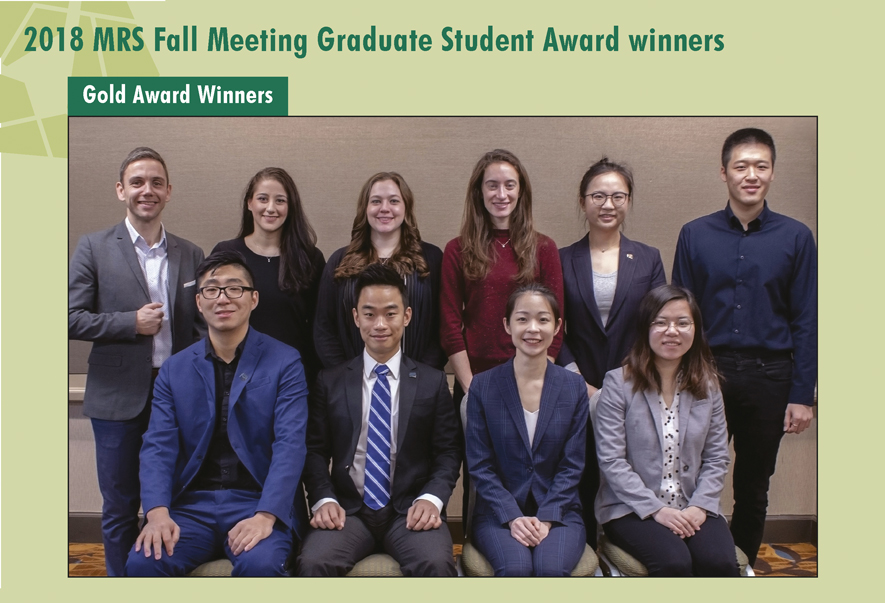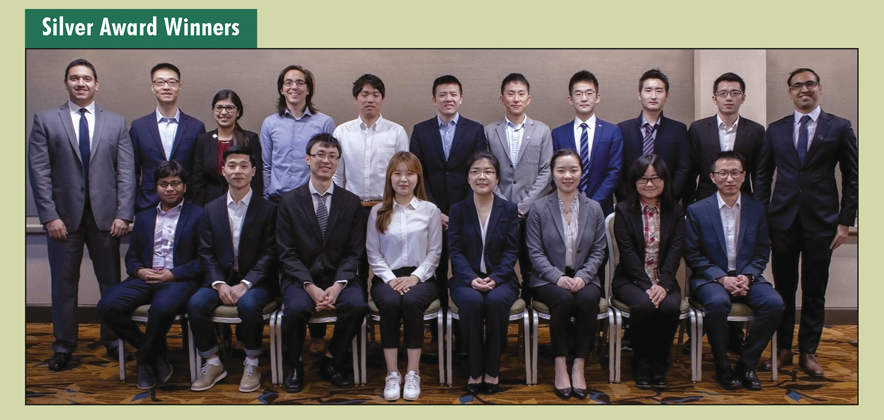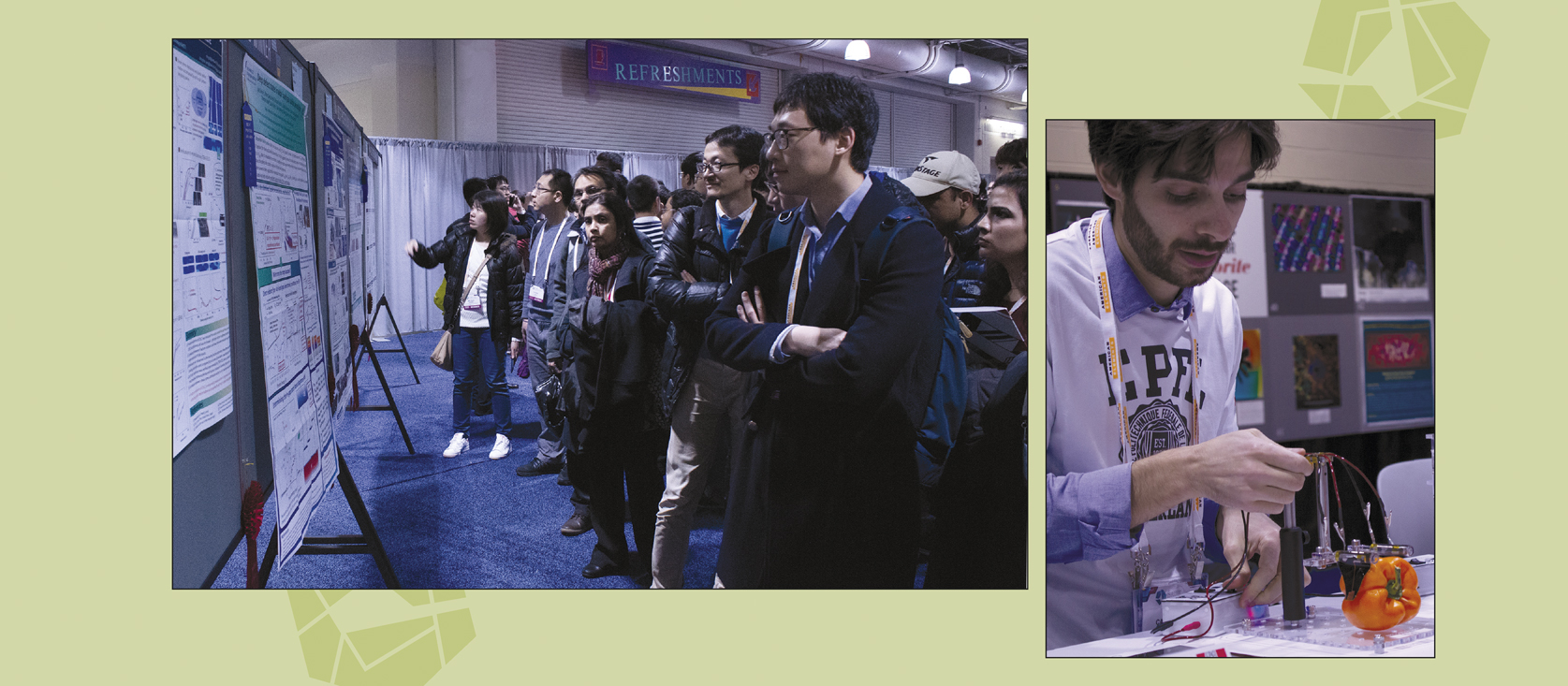More than 6500 people attended the 2018 Materials Research Society (MRS) Fall Meeting and Exhibit held in Boston from November 25 to 30. The Meeting Chairs, Kristen H. Brosnan (GE Global Research), David A. LaVan (National Institute of Standards and Technology), Patrycja Paruch (University of Geneva), Joan M. Redwing (The Pennsylvania State University), and Takao Someya (The University of Tokyo), compiled 57 symposia and organized them into nine topical areas: General Interest; Broader Impact; Biomaterials and Soft Materials; Characterization, Mechanical Properties and Structure—Property Relationships; Electronic, Photonic and Magnetic Materials; Energy—Transfer, Storage and Conversion; Nanomaterials; Processing and Manufacturing; and Thermal Properties and Thermoelectric Materials.

Top row, left to right: Mihai Duduta, Harvard University; Janna Domenico, Drexel University; Megan E. Beck, Northwestern University; Kelly W. Mauser, California Institute of Technology; Wenjie Yang, The Australian National University; Hyeon Seok An, Ulsan National Institute of Science and Technology. Bottom row, left to right: Zhe Li, Iowa State University; Seokhyoung Kim, University of North Carolina at Chapel Hill; Yayuan Liu, Stanford University; Jing Yang, Massachusetts Institute of Technology. Missing from photo: Lucas M Caretta, Massachusetts Institute of Technology; William Gent, Stanford University.
To complement these sessions, tutorials were offered in several technical areas, more than 230 exhibitors were on-site, and poster sessions were held during the evenings. An international exhibit showcased products and services of interest to the materials community. In addition, several special events highlighted science outreach.

Top row, left to right: Mohamed Elhebeary, University of Illinois at Urbana-Champaign; Yanbin Li, Stanford University; Ankita Bhutani, University of Illinois at Urbana-Champaign; Nathan Nakamura, Carnegie Mellon University; Atsunori Tanaka, University of California, San Diego; Wenjie Li, University of Wisconsin–Madison; Kehao Zhang, The Pennsylvania State University; Yue Gao, The Pennsylvania State University; Xinjian Shi, Stanford University; Qi Li, Carnegie Mellon University; Hariom Jani, National University of Singapore. Bottom row, left to right: Snehashis Choudhury, Cornell University; Ruitao Su, University of Minnesota; Xinchen Ni, Massachusetts Institute of Technology; Jiuk Jang, Ulsan National Institute of Science and Technology; Danqing Wang, Northwestern University; Meng Li, Tufts University; Lu Li, Rensselaer Polytechnic Institute; Yongtao Liu, Oak Ridge National Laboratory. Missing from photo: Victor Fung, University of California, Riverside; Jianhe Guo, The University of Texas at Austin; Ivan Lemesh, Massachusetts Institute of Technology; Mohammad Faqrul Alam Chowdhury, McGill University; Khalil Ramadi, Massachusetts Institute of Technology.
A few of the well-attended symposia include BM08: Materials-to-Devices for Integrated Wearable Systems; NM01: Carbon Nanotubes, Graphenes and Related Nanostructures; and GI03: Synthetic Biology—An Accelerator of Materials Research and Development.
The MRS Awards Program strives to acknowledge outstanding contributors to the progress of materials research and to recognize their accomplishments. At the 2018 Fall Meeting, MRS recognized Von Hippel Award recipient Hideo Hosono, Tokyo Institute of Technology, for the discovery of high Tc iron-based superconductors, creation of transparent oxide semiconductors, and inorganic electrides. M. Stanley Whittingham was selected as the David Turnbull Lectureship Award recipient. He was cited for fundamental contributions to solid-state ionics, including the discovery of the key role of intercalation mechanisms, and the development and commercialization of rechargeable Li-ion batteries.
Giulia Galli received the Materials Theory Award for the development of advanced first-principles simulation methods and their application to the understanding, prediction, and design of complex nanostructured materials. John A. Rogers was selected as the MRS Medalist for his pioneering contributions to materials for diverse classes of bio-integrated electronic systems.
Aaswath P. Raman received the inaugural MRS Nelson “Buck” Robinson Science and Technology Award for Renewable Energy for his work with radiative sky cooling technology. Ashley White received the MRS Woody White Service Award for her work in cultivating sustainable development as a core MRS activity. Hortense Le Ferrand was the recipient of the MRS Bulletin Postdoctoral Publication Prize for her excellent academic credentials, high-quality scientific publications, and science writing and communications efforts. Paula T. Hammond presented The Fred Kavli Distinguished Lectureship in Materials Science, and Laura Na Liu presented The Kavli Foundation Early Career Lectureship in Materials Science. James Bullock, University of California, Berkeley, and Minah Lee, Stanford University, each received an MRS Postdoctoral Award. Congratulations to Hariom Jani, from the National University of Singapore, for winning the Arthur Nowick Graduate Student Award

Back row, left to right: Bilen Aküzüm (2nd place); Babak Anasori (SciVid organizer); Stephen Aldersley (sponsor and president, Goodfellow Corporation). Front row, left to right: Simge Üzüm (2nd place); Stephanie Castillo (1st place); Antoni Forner-Cuenca (accepting for Rodrigo M. Ortize de la Morena (People’s Choice); Vladislav Khayrudinov (3rd place). Missing from photo: Duanduan Han (Honorable Mention).
The Public Outreach Committee featured a program on “Materials Needs for Energy Sustainability by 2050—Practical Solutions to Tackle Climate Change.” The MRS Energy & Sustainability journal, the MRS Focus on Sustainability Subcommittee, and organizers of Symposia BI01, ET14, and NM04 convened top experts to discuss the role of materials science and broader socioeconomic aspects in developing practical solutions to tackle climate change.

New to the 2018 MRS Fall Meeting was a professional development session on “Communicating Science to Nonspecialists—Science Communication Workshop.” It served as a model for scientists to engage in public and face-to-face interactions with group activities, discussions, and lectures. The session was designed to increase confidence in scientists while communicating their work and for them to become part of a community of researchers who share an interest in science outreach and engagement.
Some of the other professional development sessions included “Essentials of Getting Your Work Published,” a women’s workshop on salary negotiation, an undergraduate mentoring program breakfast, the Career Fair, ABET information and evaluator retraining, and the Women in Materials Science & Engineering Breakfast.
The Science in Video Competition (SciVid) accepted submissions of two-minute videos about a wide range of materials science topics that were intended to teach and amuse a broad audience. The finalists were posted to YouTube, where viewers were able to vote for their favorite submission for the People’s Choice Award. Babak Anasori, Drexel University, created and chaired the competition, sponsored by the MRS Foundation, Goodfellow Corporation, and A.J. Drexel Nanomaterials Institute.
Machine learning and data-driven techniques are playing a big role in the R&D of new materials, leading to faster conclusions and cost savings for materials researchers and manufacturers. In the Open Data Challenge, which had two kick-off presentations at the 2018 MRS Fall Meeting, teams curate or develop their own materials data set and apply materials informatics to that data set to learn something new. The submission deadline is February 15, and the awards will be presented at the 2019 MRS Spring Meeting. Visit www.mrs.org/fall-2018-open-data-challenge for more details.
The iMatSci Innovation Showcase featured interactive discussions on “Inclusion in Innovation,” for ways to increase diversity in STEM entrepreneurship, how to improve existing entrepreneurship support, the importance of developing an inclusive climate, and reasons why it is important to invest intentionally. Presentations on The Hub Stage included “Raising Capital 101: For Startups,” “Innovation and Industry Partnerships Panel,” and iMatSci Innovator Speed Pitches, where iMatSci Innovators presented three-minute product pitches. Additionally, all iMatSci Innovators were available at their booths to demonstrate their new materials-focused technologies designed for real-world applications.
Fall meeting attendees were able to send personalized letters to their representatives on Capitol Hill at the Materials Voice Booth. Other Advocacy offerings included a workshop on “Effective Public Policy Engagement Strategies for Researchers,” a Congressional Fellowship information session, and sessions on research funding opportunities.

These highlights and more from the 2018 MRS Fall Meeting are available through news coverage of the Meeting in Meeting Scene ® (mrsmeetingscene.org) and on MRS TV. Further information can be accessed at www.mrs.org/fall2018 .


